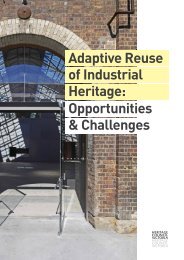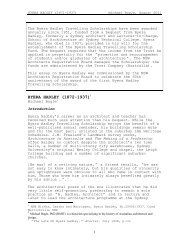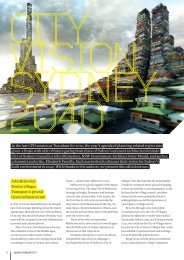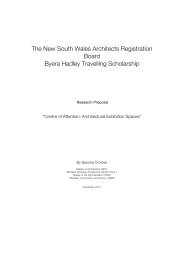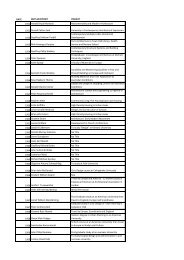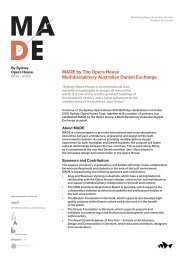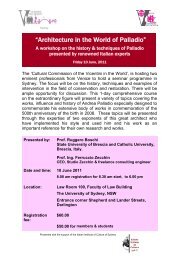4 unités LC - Architecture Insights
4 unités LC - Architecture Insights
4 unités LC - Architecture Insights
You also want an ePaper? Increase the reach of your titles
YUMPU automatically turns print PDFs into web optimized ePapers that Google loves.
of the building maintenance. It was through this interview that much of the<br />
information regarding the residents of the building, renovations, and its<br />
present condition was obtained.<br />
29 The repainting of the building took place around 10 years ago. The paint<br />
used was mixed by the very same Swiss company that had produced the<br />
original paint for the building according to the very same specifications that<br />
Le Corbusier had given them almost 40 years ago.<br />
30 The ‘Unité’ in Marseille, however, has not always been so well looked<br />
after. Previous conditions of the building are discussed in part I.4 Facilities<br />
(pp. 114-27).<br />
31 Marseille was originally a Greek settlement, founded as early as 7th century<br />
BC. It was taken over by the Romans in 49 BC, and became the major port of<br />
trade between the Orient and the West. (Fallon, S., Robinson, D., Fisher, T. +<br />
Williams, N., France, Lonely Planet Publications, Australia, 3rd Ed., 1999,<br />
pp. 666-67.)<br />
32 Hundreds of architects and designers, as well as a myriad students of these<br />
professions, continue to make ‘the pilgrimage’ (as Charles Jencks describes it<br />
in Modern Movements in <strong>Architecture</strong>, Penguin Books Ltd., England, 1986, p.<br />
14) to the ‘Unité’ in Marseille each year.<br />
33 In Robert Hughes’ claimed that the ‘Unité‘ in Marseille “stands a<br />
considerable way from the centre of Marseilles,” (Hughes, Robert, The Shock<br />
of the New – Art and the Century of Change, Thames and Hudson Ltd.,<br />
London, 1992, p. 188). The accompanying photographs (taken by Roger<br />
Viollet, Paris) used by Hughes to illustrate his points do not, unfortunately,<br />
indicate the year in which they were taken. It would seem, however, from<br />
their quality and the lack of development surrounding the building at the time<br />
that they would have been taken much earlier than the year of the book’s<br />
publication.<br />
34 Le Corbusier, The Marseilles Block, trans. Geoffrey Sainsbury, The Harvill<br />
Press, London, 1953, p. 58.<br />
35 Robert Hughes critised Le Corbusier for his inclusion of the commercial<br />
mid-level in the Marseille ‘Unité’, seeing it as ignorance on the architects<br />
131 132<br />
behalf of the fact “the French like to shop in their street markets” (Hughes,<br />
Robert, The Shock of the New – Art and the Century of Change, Thames and<br />
Hudson Ltd., London, 1992, p. 190). For anyone with a general<br />
understanding of the common French way of life, this comment would seem<br />
fair enough. It is interesting to note here, however, that although Le<br />
Corbusier may not have considered this fact, the local population has, and in<br />
so doing the markets they enjoy have come to them.<br />
36 Information, such as this, regarding historical details of the building, was<br />
gained from a presentation organised by the building co-operative as a series<br />
of panels providing an explanatory note to the building. These panels provide<br />
information to the tourists visiting the ‘Unité’ and are on display in a section<br />
of the entry foyer, at the opposite end to the lift foyer so as to be as<br />
unobtrusive as possible to the building’s inhabitants.<br />
37 The book, entitled Hip Hotels – France, was written and compiled by<br />
Herbert Ypma and published just this year by Thames & Hudson Ltd.,<br />
London, March 2001. The Hotel Le Corbusier is referred to here as one of<br />
the most notable hotels in the book’s description.<br />
38 Schools and youth recreation facilities were originally to be placed in<br />
separate buildings at the base of the ‘Unité’, and were intended to service the<br />
whole surrounding area (displayed in Le Corbusier’s second design proposal for<br />
Marseille). This arrangement would have allowed for greater interaction and<br />
communication between the children and parents of the building with those of<br />
the surrounding area. Unfortunately, the school and childcare facilities were<br />
eventually placed on the roof of the constructed ‘Unité’ to compact the<br />
design into a singular building unit.<br />
39 Despite his severe criticism of the building, Robert Hughes does, however,<br />
credit the roof terrace of the ‘Unité’ in Marseille as being “one of the great<br />
roofs of the world” comparing it to a Greek temple (Hughes, Robert, The<br />
Shock of the New – Art and the Century of Change, Thames and Hudson Ltd.,<br />
London, 1992, p. 188 + 90). Le Corbusier himself, in fact, first described the<br />
roof terrace of the ‘Unité’ as having ‘Homeric’ qualities (Le Corbusier,<br />
Modulor 2: La Parole est aux usagers, Editions de l’<strong>Architecture</strong><br />
d’Aujourd’hui, Paris, 1991, p. 304), although others have since agreed with<br />
him (see Gans, Deborah, The Le Corbusier Guide, Princeton Architectural<br />
Press, New York, Revised Ed., 2000, p. 115).






